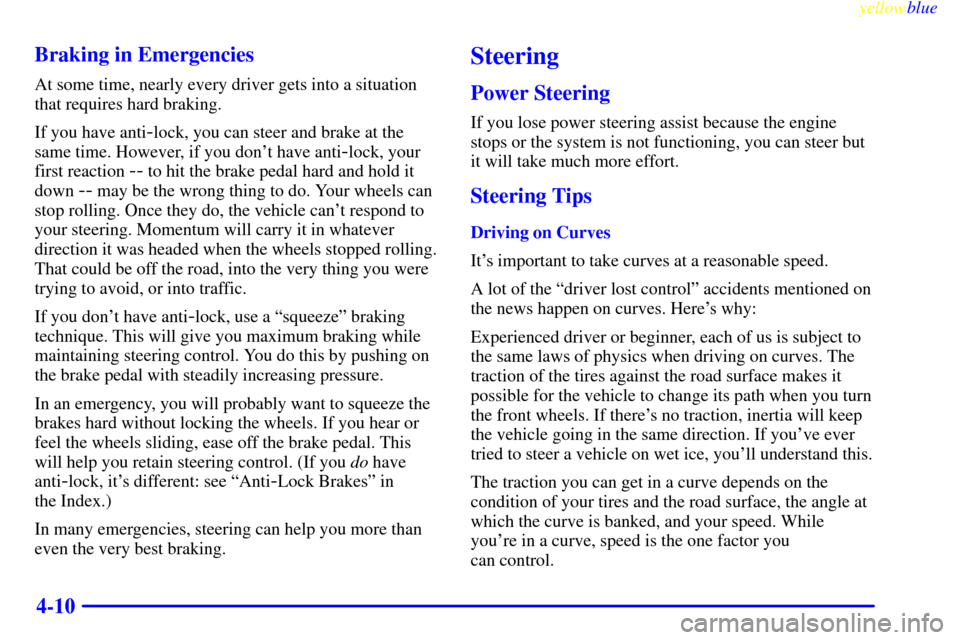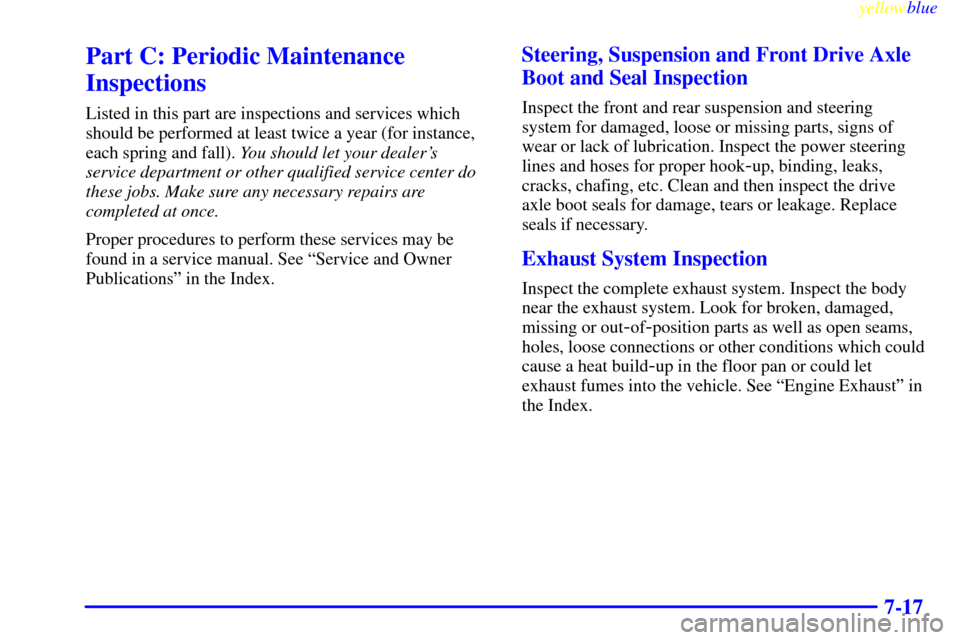Page 141 of 336

yellowblue
3-19 Audio Steering Wheel Controls
(If Equipped)
If your vehicle has this feature, you can control certain
radio functions using the buttons on your steering wheel.
SEEK: Press the up arrow
to tune to the next radio
station and the down
arrow to tune to the
previous radio station.
If a cassette tape or compact disc is playing, the player
will advance with the up arrow and rewind with the
down arrow.
PRESET: Press this button to play a station you have
programmed on the radio preset buttons.
AM
-FM: Press this button to choose AM, FM1 or FM2.
If a cassette tape or compact disc is playing, it will stop
and the radio will play.
VOLUME: Press the up or
down arrow to increase or
decrease volume.
PLAY: Press this button to play a cassette tape or
compact disc when the radio is playing.
MUTE: Press this button to silence the system. Press it
again to turn on the sound.
Understanding Radio Reception
AM
The range for most AM stations is greater than for FM,
especially at night. The longer range, however, can
cause stations to interfere with each other. AM can pick
up noise from things like storms and power lines. Try
reducing the treble to reduce this noise if you ever get it.
Page 154 of 336

yellowblue
4-10 Braking in Emergencies
At some time, nearly every driver gets into a situation
that requires hard braking.
If you have anti
-lock, you can steer and brake at the
same time. However, if you don't have anti
-lock, your
first reaction
-- to hit the brake pedal hard and hold it
down
-- may be the wrong thing to do. Your wheels can
stop rolling. Once they do, the vehicle can't respond to
your steering. Momentum will carry it in whatever
direction it was headed when the wheels stopped rolling.
That could be off the road, into the very thing you were
trying to avoid, or into traffic.
If you don't have anti
-lock, use a ªsqueezeº braking
technique. This will give you maximum braking while
maintaining steering control. You do this by pushing on
the brake pedal with steadily increasing pressure.
In an emergency, you will probably want to squeeze the
brakes hard without locking the wheels. If you hear or
feel the wheels sliding, ease off the brake pedal. This
will help you retain steering control. (If you do have
anti
-lock, it's different: see ªAnti-Lock Brakesº in
the Index.)
In many emergencies, steering can help you more than
even the very best braking.
Steering
Power Steering
If you lose power steering assist because the engine
stops or the system is not functioning, you can steer but
it will take much more effort.
Steering Tips
Driving on Curves
It's important to take curves at a reasonable speed.
A lot of the ªdriver lost controlº accidents mentioned on
the news happen on curves. Here's why:
Experienced driver or beginner, each of us is subject to
the same laws of physics when driving on curves. The
traction of the tires against the road surface makes it
possible for the vehicle to change its path when you turn
the front wheels. If there's no traction, inertia will keep
the vehicle going in the same direction. If you've ever
tried to steer a vehicle on wet ice, you'll understand this.
The traction you can get in a curve depends on the
condition of your tires and the road surface, the angle at
which the curve is banked, and your speed. While
you're in a curve, speed is the one factor you
can control.
Page 230 of 336
yellowblue
6-10
When you open the hood on the 3100 (Code M) V6 engine, you'll see:
A. Engine Coolant Reservoir
B. Radiator Fill Cap
C. Power Steering Fluid Reservoir
D. Engine Oil Fill Cap
E. Engine Oil DipstickF. Automatic Transaxle
Fluid Dipstick
G. Brake Fluid Reservoir
H. Engine Air Cleaner/Filter
I. Remote Positive (+)
Battery TerminalJ. Windshield Washer
Fluid Reservoir
K. Battery (located under
Windshield Washer
Fluid Reservoir)
Page 231 of 336
yellowblue
6-11
When you open the hood on the 3800 (Code K) V6 engine, you'll see:
A. Engine Coolant Reservoir
B. Radiator Fill Cap
C. Power Steering Fluid Reservoir
D. Engine Oil Dipstick
E. Engine Oil Fill CapF. Automatic Transaxle
Fluid Dipstick
G. Brake Fluid Reservoir
H. Engine Air Cleaner/Filter
I. Remote Positive (+)
Battery TerminalJ. Windshield Washer
Fluid Reservoir
K. Battery (located under
Windshield Washer
Fluid Reservoir)
Page 246 of 336
yellowblue
6-26
CAUTION:
Turning the radiator pressure cap when the
engine and radiator are hot can allow steam
and scalding liquids to blow out and burn you
badly. With the coolant recovery tank, you will
almost never have to add coolant at the radiator.
Never turn the radiator pressure cap
-- even a
little
-- when the engine and radiator are hot.
CAUTION:
You can be burned if you spill coolant on hot
engine parts. Coolant contains ethylene glycol,
and it will burn if the engine parts are hot
enough. Don't spill coolant on a hot engine.
Power Steering Fluid
3100 (Code M)
V6 Engine 3800 (Code K)
V6 Engine
When to Check Power Steering Fluid
It is not necessary to regularly check power steering
fluid unless you suspect there is a leak in the system or
you hear an unusual noise. A fluid loss in this system
could indicate a problem. Have the system inspected
and repaired.
Page 247 of 336
yellowblue
6-27 How to Check Power Steering Fluid
When the engine compartment is cool, wipe the cap and
the top of the reservoir clean, then unscrew the cap and
wipe the dipstick with a clean rag. Replace the cap and
completely tighten it. Then remove the cap again and
look at the fluid level on the dipstick.
When the engine
compartment is hot, the
level should be at the
H mark. When it's cold,
the level should be at the
C mark. If the fluid is at
the ADD mark, you should
add fluid.
3100 (Code M) V6
Engine
For the 3800 engine, the
level should be at the HOT
mark when the engine
compartment is hot. If the
fluid is at the ADD mark,
you should add fluid.
3800 (Code K) V6
Engine
What to Use
To determine what kind of fluid to use, see
ªRecommended Fluids and Lubricantsº in the Index.
Always use the proper fluid. Failure to use the proper
fluid can cause leaks and damage hoses and seals.
Page 278 of 336

yellowblue
6-58
Fuse Description
12 Anti
-Theft/PCM -- Theft-Deterrent
Module, Powertrain Control Module,
(PCM) IGN System Relay
13 ABS
-- Electronic Brake Control
Module (EBCM), ABS Relay
14 HVAC Blower Motor
-- Blower
Motor Relay
15 L.H. Spot Lamp (S.E.O.)
16 Steering Wheel Control #1
-- Steering
Wheel Radio Control Lighting
17 Not Used
18 Not Used
19 Power Accessory #1
-- Door Lock
Switches, Trunk Courtesy Lamp, O/S
Mirror Switch, (S.E.O.) Emergency
Vehicle
-Rear Compartment Lid Lamp or
Window Panel Lamps
20 Steering Wheel Control #2
-- Steering
Wheel Radio ControlsFuse Description
21 Air Bag
-- Air Bag System
22 Cruise Control
--Cruise Control Cut-Out
Switch, Cruise Control Module, Turn
Signal Cruise Control Switches
23 Stoplamps
-- Stoplamp Switch (Brake)
24 Not Used
25 English/Metric (S.E.O.)
26 Not Used
27 Not Used
28 CTSY Lamps
-- Vanity Mirrors, I/P
Compartment Lamp, I/S Lighted
Rearview Mirror, Dome Lamp
29 Wiper
-- Wiper Switch
30 Turn Signal
-- Turn Signal Flasher
31 Not Used
32 Power Locks
-- Door Lock Relay,
Remote Keyless Entry Receiver
Page 303 of 336

yellowblue
7-17
Part C: Periodic Maintenance
Inspections
Listed in this part are inspections and services which
should be performed at least twice a year (for instance,
each spring and fall). You should let your dealer's
service department or other qualified service center do
these jobs. Make sure any necessary repairs are
completed at once.
Proper procedures to perform these services may be
found in a service manual. See ªService and Owner
Publicationsº in the Index.
Steering, Suspension and Front Drive Axle
Boot and Seal Inspection
Inspect the front and rear suspension and steering
system for damaged, loose or missing parts, signs of
wear or lack of lubrication. Inspect the power steering
lines and hoses for proper hook
-up, binding, leaks,
cracks, chafing, etc. Clean and then inspect the drive
axle boot seals for damage, tears or leakage. Replace
seals if necessary.
Exhaust System Inspection
Inspect the complete exhaust system. Inspect the body
near the exhaust system. Look for broken, damaged,
missing or out
-of-position parts as well as open seams,
holes, loose connections or other conditions which could
cause a heat build
-up in the floor pan or could let
exhaust fumes into the vehicle. See ªEngine Exhaustº in
the Index.